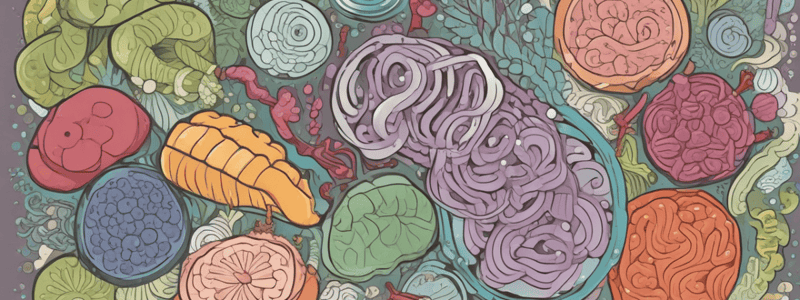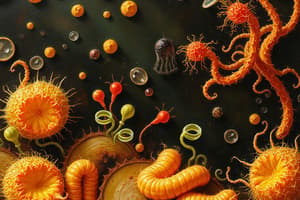Podcast
Questions and Answers
What is the primary purpose of pasteurization in food processing?
What is the primary purpose of pasteurization in food processing?
To kill pathogens that can cause food-borne illnesses
How can pathogens contaminate food?
How can pathogens contaminate food?
Through air, water, soil, sewage, and surfaces, as well as human skin, nasal passages, and large intestines
What is cross-contamination of food?
What is cross-contamination of food?
The transfer of pathogens from one food or surface to another
What is the result of a parasitic infection on the host organism?
What is the result of a parasitic infection on the host organism?
What are some examples of foods that rely on microorganisms for their production?
What are some examples of foods that rely on microorganisms for their production?
What is the difference between beneficial and pathogenic microorganisms in food?
What is the difference between beneficial and pathogenic microorganisms in food?
What are some examples of contaminants that can enter food unintentionally?
What are some examples of contaminants that can enter food unintentionally?
What happens when food is contaminated with pathogens?
What happens when food is contaminated with pathogens?
What type of animals can harbor harmful microbes on and in their bodies, especially in their intestinal tracts?
What type of animals can harbor harmful microbes on and in their bodies, especially in their intestinal tracts?
What is a common route for transmitting harmful microbes?
What is a common route for transmitting harmful microbes?
How do people contaminate their hands with pathogens?
How do people contaminate their hands with pathogens?
Why is it important to wash cutting boards and food preparation utensils after they come in contact with raw meat or poultry?
Why is it important to wash cutting boards and food preparation utensils after they come in contact with raw meat or poultry?
What is pasteurization, and what is its purpose?
What is pasteurization, and what is its purpose?
What conditions do most microbes need to survive and multiply?
What conditions do most microbes need to survive and multiply?
What type of foods are likely to harbor pathogens?
What type of foods are likely to harbor pathogens?
What are some examples of high-risk foods and their primary pathogens?
What are some examples of high-risk foods and their primary pathogens?
Why is it important to cook foods properly?
Why is it important to cook foods properly?
What can happen if contaminated cutting boards and utensils are used to prepare other foods?
What can happen if contaminated cutting boards and utensils are used to prepare other foods?
Flashcards are hidden until you start studying
Study Notes
Pathogens in Food
- For thousands of years, people have used microorganisms to produce foods like hard cheeses, raised breads, and alcoholic beverages.
- Beneficial microorganisms secrete substances that alter food characteristics, while harmful ones spoil food and make it unfit for consumption.
- Parasites like microorganisms grow and multiply in food, obtaining nourishment from the host's tissues, causing harm to the host's health.
Sources of Pathogens
- Pathogens can be found in air, water, soil, sewage, and on various surfaces.
- Human skin, nasal passages, and large intestines have colonies of microbes, some of which can be pathogenic.
- Animals, including cats, dogs, reptiles, cattle, and poultry, can harbor harmful microbes on and in their bodies.
Common Routes for Transmitting Pathogens
- Vermin like flies, cockroaches, mice, and rats can transfer pathogens to humans when they come in contact with filth and then with food.
- Poor personal hygiene practices, like not washing hands after using the toilet or changing diapers, can transfer microbes to food.
- Animals can also transfer pathogens to food through their feces, skin, and fur.
Cross-Contamination of Food
- Improper food handling can result in food-borne illness, such as failing to wash cutting boards and utensils after contact with raw meat or poultry.
- Cross-contamination can occur when contaminated boards and utensils are used to prepare other foods, transferring pathogens.
Pasteurization
- Pasteurization is a special heating process used to destroy pathogens in food.
- Many commercial food producers use pasteurization, such as for juices and milk in the United States.
Conditions that Favor Pathogen Survival and Multiplication
- Most microbes need warmth, moisture, and a source of nutrients to survive and multiply.
- High-risk foods are warm, moist, and protein-rich, with a neutral or slightly acidic pH.
High-Risk Foods
- High-risk foods include meats, eggs, milk, and products made from milk, which fit the description of warm, moist, and protein-rich with a neutral or slightly acidic pH.
- Table 12.1 lists high-risk foods and their primary pathogens, such as rare hamburger with Salmonella species and E. coli O157:H7.
Studying That Suits You
Use AI to generate personalized quizzes and flashcards to suit your learning preferences.




